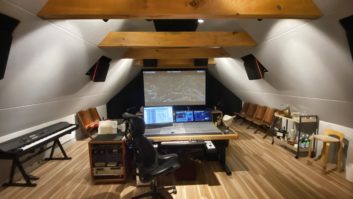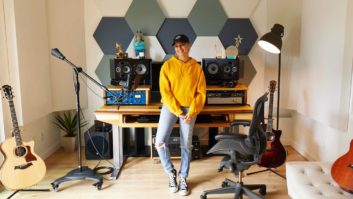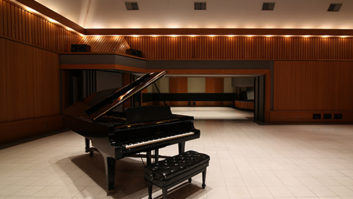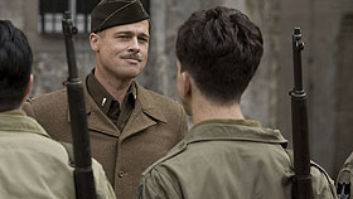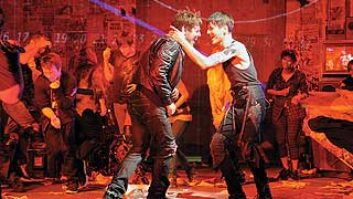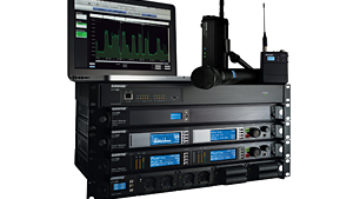
After working for more than 20 years in theatrical sound design, Janet Kalas has seen and heard her fair share of productions. Two of her recent projects are critically acclaimed shows: the Tony Award™-winning Take Me Out and Hank Williams: Lost Highway. Kalas recently spoke with Mixto shed some light on her techniques for these productions and her sound design background.
“I started my sound design career in Baltimore at Center Stage,” Kalas begins. “I was the house engineer and sound designer for several years. At the time, sound design wasn’t really a vocation, so I learned the craft hands-on. During my few months as an audio engineer at the Denver Center for the Performing Arts, sound designers Bruce Odland and Bill Ballou introduced me to the concept of spatial sound by placing speakers throughout the theater house, as well as strategic placements onstage, including building speakers into scenery if need be. Eventually, I moved to New York and began working in off-Broadway theaters such as Manhattan Theater Club and Playwrights Horizons.”
As with all aspects of audio production, Kalas’ sound design techniques changed with the proliferation of digital audio gear. “In the 1980s, I was recording my own sound effects,” she recalls, “because the only available sound effect libraries were on records, and I detested pops and clicks from vinyl. I had a portable, battery-operated Sony TCD 5M cassette recorder and a couple of respectable microphones. I would record the sounds I needed for a production: anything from chickens to bells to trains.
“Later, I would transfer the audio to reel-to-reel tape, leader it and make it ready to use in the show. I was very good with the old razor-blade-and-tape-editing technique. Sometime around the late ’80s or early ’90s, Software Audio Workshop’s [SAW] PC editing software came out and I jumped right into it. It changed my life: It went from all-night editing sessions and sleeping under the console to having an incredible, fast, efficient, versatile tool. I still use SAW, but I am also very familiar with Pro Tools.

“After sounds have been edited, I load them into the playback system chosen for the show. In both shows, we used SFX from Stage Research, a program used to create playlists with audio cues and/or MIDI triggers. In Lost Highway, SFX acted as playlist and playback for the sound effects. Take Me Out utilizes SFX as a playlist, which then triggers an Akai S6000 sampler. Samples for Take Me Out were exported from Pro Tools as .WAV files and loaded onto the S6000’s hard drive. The SFX system has the advantage of being considerably easier to learn. In smaller venues that can’t afford sophisticated playback systems, MiniDisc works very well, particularly during technical rehearsals, since you can reorder tracks on-the-spot. CDs are often used as cue playback for the run of the production.”
Kalas’ cues in Take Me Out combine pre-existing sound effects mixed with sounds specifically recorded for this show. “I have collected a fairly extensive library of sounds over the years,” she explains, “as well as utilizing commercial sound libraries, which are quite stunning these days. It’s a baseball play, so I had to sonically re-create three baseball games. I had to capture the emotions [of a baseball game] based upon specifics in the script. For example, in the second game sequence, the crowd watches as their team begins to come from behind to win the game. I had to capture the anger or frustration of the crowd and the all-out excitement of the moment. Building that into 45 seconds — the duration of ‘the big game’ — and following the text very specifically was a challenge. That particular sequence has extensive layering to create the emotion of the game. Effects such as the crack of the bat and crowd cheering came from my library. In addition, I recorded actors from the production performing specific cheers and voice-overs using a Sony PCM-M1 portable DAT recorder with a Neumann U87 and/or Audio-Technica AT825 stereo mic.”
Riding atop the crowd sounds, effects and music in Take Me Out are the voices of two actors narrating the baseball scenes. “It’s important that the actors’ voices are lifted above the crowd,” Kalas stresses, “so that the crowd sounds aren’t pulled down in order for the narrators to be heard. They are miked using DPA 4061 miniature omni microphones connected to Sennheiser SK 5012 wireless transmitter packs. The Sennheiser wireless systems are workhorses, have great response and have always been reliable. The DPA mics sound fantastic and don’t need much EQ. The 4061s are specifically designed for mounting near the body, and the response varies somewhat depending upon placement. The best scenario is to place the mic at the center of the actor’s forehead at the hairline or over the ear pointing toward the mouth. You can place the mic on a lapel, but if there are costume changes, it’s better on the actor’s head. There are several methods for securing a mic over the ear, such as using a small wire or plastic armature, which is designed to fit comfortably. The mic cable is secured to the armature with tape, which can be colored to skin tone, or floral wire. Sweat-resistant surgical tape can be used to secure the mic cable along the neck. Toupee clips or bobby pins can be used to clip the cable securely into the hair. The most important thing is to get the mic as close to the performer’s mouth as possible to overcome extraneous noise.”
Kalas has observed that in recent times, many theatrical performances are utilizing vocal reinforcement. “Plays might be reinforced with wireless microphones, shotgun mics, mics placed along the front edge of the stage or discretely on the set, etc.,” she notes. “In all Broadway musicals, the performers use wireless mics and the orchestra is miked. For musicals, it’s all about controlling the mix; controlling exactly what the audience hears.
“In the past, you could expect an actor to project to an audience. If you couldn’t hear them, you’d give a note to the director and the director would ask the actor to speak up. Nowadays, the big draw for a lot of Broadway plays and musicals are film or TV actors who aren’t necessarily vocally trained to fill a 2,000-seat house. The challenge often falls to myself and my audio team to make sure that they are heard. But I can only support or amplify what they give me. If they mumble, it is going to be an amplified mumble. There is not much I can do about that.”
NAVIGATING THE LOST HIGHWAY
Sound design requirements for Hank Williams: Lost Highway were considerably different from those of Take Me Out, largely due to venue and the nature of the production. Lost Highway played at the Little Schubert Theater, a venue Kalas describes as a “raked orchestra-level theater with no balconies. It is a wider, taller space than the Walter Kerr Theater, and much of the audience is farther from the stage than at the Walter Kerr. Take Me Out is an acoustically three-dimensional show. I want the audience to feel like they are a part of the crowd. As a result, sound comes not only from front-, but also from rearfill speakers, and not subtly: It’s loud in the rearfill at times. The sound system has many areas or zones, which add depth and dimension. There are many scene changes in Take Me Out. One scene opens with a press conference. The sound effect cue for that scene change is a series of camera clicks, as if many photographers are taking photos. Those sounds come from many areas of the system so that it sounds as if there are photographers all over the house. The Akai sampler works nicely for that kind of cue sequence because it has multiple outputs that are connected to a Crest console that feeds the various zones.
“Lost Highway is more presentational: You are watching and hearing the action in front of you. There are some sound effects such as crickets and bird cues pulled back into the house for depth, but the action is essentially in front, so there aren’t as many powerful speakers in the back of the house. The basic arrays are Meyer UPAs with EAW JF80s for side- and rearfill. Like most musicals, Lost Highway requires a lot of inputs. Each performer had a DPA 4061 with a Sony transmitter. We placed a wireless mic — a Sennheiser MKE2 red dot — on the upright and electric bass, plus an offstage amplifier for the steel guitar, which was miked. At one point, Jason Petty, the actor who plays Hank Williams, is supposed to be performing at the Grand Ole Opry, so we used an old-fashioned-looking Shure 55SH Series II stand mic: a reproduction of a mic commonly used in the ’40s and ’50s.
“The big challenge for Lost Highway was that I was offered the job just two weeks before the show was supposed to go into the theaters, which doesn’t allow for much time for prep or planning. It had been running downtown at a small theater and they wanted to move it up to the Little Schubert. It can be difficult when producers decide to move a show to a different venue because they often think, ‘Well, you’ve done this already, so we can just throw it into this new space.’ That is not the case. Every load-in, every new tech requires a lot of time because there are so many different elements to consider. Typically, a production goes into what we call the tech period — technical rehearsal — that can be several days to several weeks prior to the first preview. We tech through the script page by page for the first few days, and then run the show to see how it works and make appropriate adjustments. Then we repeat the process until we get it right or until the show opens. Since theater is live and no performance is exactly the same, most cues are run off a word in the text, cued by the stage manager, to keep the timing correct. Cue timing can be adjusted by editing or remixing the cue, adjusting the cues in SFX or by asking the stage manager to call a cue in a different place. While we are making adjustments, the audio engineer who runs the show has the chance to learn the show and the timing.
“When Lost Highway went into the preview period, we were still tech’ing during the day. The preview period was only a matter of days. We negotiated with the previous sound designer to use his sound effects, which was a huge relief because there are a great many sound effects in that show. Then it was a matter of designing the sound system for the space and getting it into the theater while working within a relatively small budget. It was a very tight schedule, but that is the wonder and the glory of theater: pulling together people who have never worked together before and creating something that sounds and looks incredible.”
Steve LaCerra is a veteran journalist for the pro audio industry and is based out of New York City.
